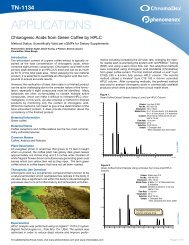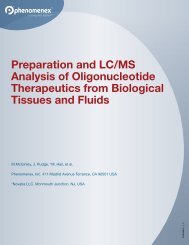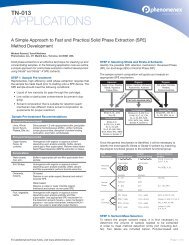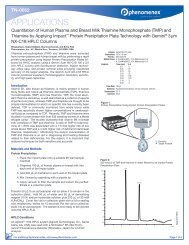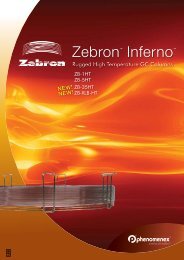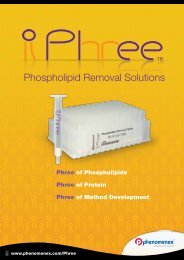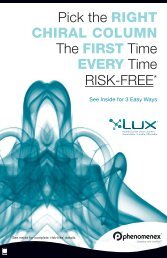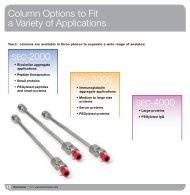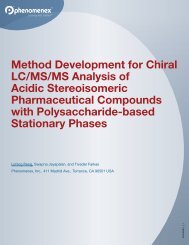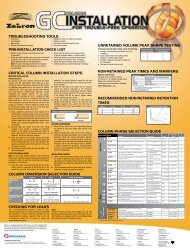Improved Separation of Explosives (Nitroaromatics ... - Phenomenex
Improved Separation of Explosives (Nitroaromatics ... - Phenomenex
Improved Separation of Explosives (Nitroaromatics ... - Phenomenex
Create successful ePaper yourself
Turn your PDF publications into a flip-book with our unique Google optimized e-Paper software.
HPLC<br />
TN-1036<br />
<strong>Improved</strong> <strong>Separation</strong> <strong>of</strong> <strong>Explosives</strong> (<strong>Nitroaromatics</strong>)<br />
for HPLC Analysis Using Synergi Hydro-RP and Synergi<br />
Polar-RP (EPA Method 8330)<br />
Introduction<br />
The need for disposal <strong>of</strong> expired munitions from armed forces<br />
has attained considerable importance during the last two decades<br />
partially due to the dismantling <strong>of</strong> military installations<br />
and disarmament treaties around the world. Improper storage<br />
and disposal techniques have resulted in contamination <strong>of</strong> soil<br />
and ground water with explosive residues including 2,4,6-trinitrotoluene<br />
(TNT) and nitrobenzene. Recent studies have shown<br />
that these compounds can cause liver damage and are suspected<br />
mutagens (1). Because <strong>of</strong> these health risks, analytical<br />
methods for the thorough identification and characterization <strong>of</strong><br />
the contaminated areas are in high demand. EPA Method 8330,<br />
introduced in November 1990, is the most common way to analyze<br />
samples for the presence <strong>of</strong> explosives. The method recommends<br />
using a C18 phase as a primary column and a CN phase<br />
as a confirmation column. Confirmation columns are sometimes<br />
needed because <strong>of</strong> difficulty in separating similar compounds<br />
on a single stationary phase. By using two columns with different<br />
selectivities, analysts can more accurately identify the compounds<br />
<strong>of</strong> interest. Closely eluting and co-eluting peaks on a<br />
typical C18 column include 2,4,6-trinitrotoluene, 4-amino-dinitrotoluene,<br />
and 2-amino-dinitrotoluene. In addition, separation<br />
<strong>of</strong> 2,6-dinitrotoluene and 2,4-dinitrotoluene can sometimes be<br />
difficult. In this application note, we describe the analysis <strong>of</strong> 15<br />
explosives using a polar endcapped 4 μm C18 reversed phase<br />
(Synergi Hydro-RP) as the primary column and a polar endcapped<br />
4 μm ether-linked phenyl phase (Synergi Polar-RP) as<br />
the confirmation column.<br />
Experimental Conditions<br />
The HPLC analysis was carried out using an HP 1100 LC<br />
system (Agilent Technologies, Palo Alto, California) equipped with a<br />
quaternary pump, in-line degasser, multi-wavelength detector,<br />
and autosampler. HP Chemstation s<strong>of</strong>tware (Version A.08.03) was<br />
used for data analysis. The HPLC columns used for this analysis<br />
were Synergi Hydro-RP 250 x 4.6 mm and Synergi Polar-RP 250<br />
x 4.6 mm (<strong>Phenomenex</strong>, Torrance, California). The mobile phase<br />
composition is listed in Table 1. The detection wavelength used<br />
was 254 nm, and a column oven temperature <strong>of</strong> 35 °C. Standards<br />
were obtained from Restek (Bellefonte, Pennsylvania).<br />
Table 1: HPLC method conditions and peak identification<br />
Columns:<br />
Samples:<br />
Mobile Phase:<br />
Flow Rate:<br />
Detection:<br />
Column temp.: 35 °C<br />
(1) Synergi Hydro-RP 4 μm 80 Å 250 x 4.6 mm<br />
(2) Synergi Polar-RP 4 μm 80 Å 250 x 4.6 mm<br />
1 = HMX, 2 = RDX, 3 = 1,3,5-Trinitrobenzene<br />
5 = Tetryl, 6 = 1,3-Dinitrobenzene<br />
7 = Nitrobenzene, 8 = 2,4,6-Trinitrotoluene<br />
9 = 4-Amino-2,6 Dinitrotoluene<br />
10 = 2-Amino-4,6 Dinitrotoluene<br />
11 = 2,6-Dinitrotoluene, 12 = 2,4-Dinitrotoluene<br />
13 = 2-Nitrotoluene, 14 = 4-Nitrotoluene<br />
15 = 3-Nitrotoluene, 4 = 1,2-Dinitrobenzene (internal standard)<br />
(1) A: 51 % Water, B: 45 % Methanol, C: 4 % Acetonitrile<br />
(2) A: 60 % Water B: 5 % Methanol C: 35 % Acetonitrile<br />
(1) 0.8 mL/min (2) 1.0 mL/min<br />
UV @ 254 nm<br />
Results and Discussion<br />
Experiments performed resulted in a major improvement in the<br />
separation <strong>of</strong> the common explosives in EPA 8330 compared to<br />
typical C18 phases. Figure 1 shows a chromatogram <strong>of</strong> the explosives<br />
standard injected at about 25 ng on-column. The Synergi<br />
Hydro-RP column is able to achieve separation <strong>of</strong> all <strong>of</strong> the EPA<br />
Method 8330 compounds versus the standard method, which<br />
describes the use <strong>of</strong> two columns (a C18 phase combined with a<br />
cyano phase). Dense bonding coupled with unique polar endcapping<br />
in the Synergi Hydro-RP phase gives added retention and<br />
improved selectivity for neutral to polar compounds. This results<br />
in improved separation <strong>of</strong> EPA Method 8330 compounds. Quantitation<br />
<strong>of</strong> individual components using Synergi Hydro-RP is more<br />
accurate due to the resolution achieved. A second confirmation<br />
run can be avoided due to the improved separation <strong>of</strong> the explosives<br />
mix. This will improve sample throughput and decrease<br />
analysis time. We also decreased the flow rate from 1.5 mL/min to<br />
0.8 mL/min, which will decrease solvent consumption.<br />
www.phenomenex.com<br />
<strong>Phenomenex</strong> products are available worldwide. For the distributor in your country,<br />
contact <strong>Phenomenex</strong> USA, International Department by telephone, fax or email: international@phenomenex.com.<br />
tel.:<br />
fax:<br />
email:<br />
Australia<br />
02-9428-6444<br />
02-9428-6445<br />
info@<br />
phenomenex.com.au<br />
Austria<br />
01-319-1301<br />
01-319-1300<br />
anfrage@<br />
phenomenex.com<br />
Canada<br />
(800) 543-3681<br />
(310) 328-7768<br />
info@<br />
phenomenex.com<br />
Denmark<br />
4824 8048<br />
4810 6265<br />
dkinfo@<br />
phenomenex.com<br />
France<br />
01 30 09 21 10<br />
01 30 09 21 11<br />
franceinfo@<br />
phenomenex.com<br />
Germany<br />
06021-58830-0<br />
06021-58830-11<br />
anfrage@<br />
phenomenex.com<br />
tel.:<br />
fax:<br />
email:<br />
Ireland<br />
01 247 5405<br />
+44 1625-501796<br />
eireinfo@<br />
phenomenex.com<br />
Italy<br />
051 736176<br />
051 735302<br />
italiainfo@<br />
phenomenex.com<br />
New Zealand<br />
09-4780951<br />
09-4780952<br />
info@<br />
phenomenex.co.nz<br />
Puerto Rico<br />
(800) 541-HPLC<br />
(310) 328-7768<br />
info@<br />
phenomenex.com<br />
United Kingdom<br />
01625-501367<br />
01625-501796<br />
ukinfo@<br />
phenomenex.com<br />
USA<br />
(310) 212-0555<br />
(310) 328-7768<br />
info@<br />
phenomenex.com
HPLC<br />
TN-1036<br />
Figure 1: EPA Explosive mix using Synergi Hydro-RP<br />
6<br />
Figure 2: EPA Explosive mix using Synergi Polar-RP<br />
9,10<br />
3<br />
7<br />
12<br />
5<br />
10<br />
1<br />
2<br />
4<br />
9<br />
11<br />
13<br />
14<br />
15<br />
App ID 14768<br />
2<br />
1<br />
7 6<br />
4<br />
15 14<br />
13<br />
11<br />
12<br />
3<br />
8<br />
5<br />
App ID 14768<br />
0 10 20 min<br />
0<br />
10 20 30 40 min<br />
If a confirmation column is needed, then Synergi Polar-RP can<br />
be used to confirm peak identity. As shown in Figure 2, Synergi<br />
Polar-RP was able to improve separation <strong>of</strong> 2,4,6-trinitrotoluene<br />
(peak 7) from 4-amino-dinitrotoluene (peak 8), tetryl (peak 4)<br />
from 1,3-dinitrobenzene (peak 5), and 2,6-dinitrotoluene (peak<br />
10) from 2,4-dinitrotoluene (peak 11) versus what is typically observed<br />
using a cyano (CN) column.<br />
Using Synergi Hydro-RP combined with Synergi Polar-RP as<br />
a confirmation column will ensure proper identification <strong>of</strong> EPA<br />
Method 8330 compounds with improved quantitation, lower solvent<br />
consumption, and higher throughput.<br />
5395_L<br />
Standard is a mixture <strong>of</strong> the following components:<br />
1 = HMX, 2 = RDX, 3 = 1,3,5 Trinitrobenzene, 4 = 1,2-Dinitrobenzene (internal standard), 5<br />
=Tetryl, 6 = 1,3-Dinitrobenzene, 7 = Nitrobenzene, 8 = 2,4,6-Trinitrotoluene, 9 =4-Amino-2,6<br />
Dinitrotoluene, 10 = 2-Amino-4,6 Dinitrotoluene, 11 = 2,6-Dinitrotoluene, 12 = 2,4-Dinitrotoluene,<br />
13 = 2-Nitrotoluene, 14 = 4- Nitrotoluene, 15 = 3-Nitrotoluene.<br />
Standard mixture is the same as in figure 1. Note the change in elution order for<br />
many <strong>of</strong> the components:<br />
2 = RDX, 1 = HMX, 7 = Nitrobenzene, 6 = 1,3-Dinitrobenzene, 4 = 1,2-Dinitrobenzene<br />
(internal standard), 9 = 4-Amino-2,6 Dinitrotoluene, 10 = 2-Amino-4,6 Dinitrotoluene, 13 =<br />
2-Nitrotoluene,15 = 3-Nitrotoluene, 14 = 4-Nitrotoluene, 11 = 2,6-Dinitrotoluene, 12 = 2,4-<br />
Dinitrotoluene, 3 =1,3,5-Trinitrobenzene, 8= 2,4,6-Trinitrotoluene, 5 = Tetryl.<br />
Reference<br />
1. L. Berthe-Corti, H. Jacobi, S. Kleihauer, and I. Witte,<br />
“Cytotoxicity and Mutagenicity <strong>of</strong> (TNT) and Hexogen<br />
Contaminated Soil in S. typhimurium and Mammalian<br />
Cells,” Chemosphere 2, 209–218 (1998).<br />
Ordering Information<br />
2.5 μm HST (High Speed Technology) Formats (mm)<br />
Phase 30 x 2.0 50 x 2.0 50 x 4.6<br />
Synergi Hydro-RP 00A-4387-B0 00B-4387-B0 00B-4387-E0<br />
Synergi Polar-RP 00A-4371-B0 00B-4371-B0 00B-4371-E0<br />
4.0 μm Analytical Columns (mm)<br />
Phase 50 x 4.6 150 x 4.6 250 x 4.6<br />
Synergi Hydro-RP 00B-4375-E0 00F-4375-E0 00G-4375-E0<br />
Synergi Polar-RP 00B-4336-E0 00F-4336-E0 00G-4336-E0<br />
Additional dimensions, phases, and particle sizes are available.<br />
Please visit www.phenomenex.com or contact us for more details.<br />
Copyright © 2007 <strong>Phenomenex</strong> Inc. All rights reserved. <strong>Phenomenex</strong> is a registered trademark <strong>of</strong> <strong>Phenomenex</strong>, Inc. Synergi is a trademark <strong>of</strong> <strong>Phenomenex</strong>, Inc.<br />
Copying or re-use <strong>of</strong> this information is not allowed without written permission from <strong>Phenomenex</strong>.



